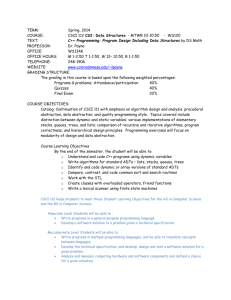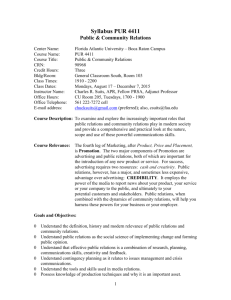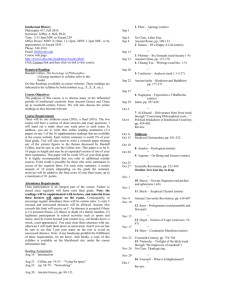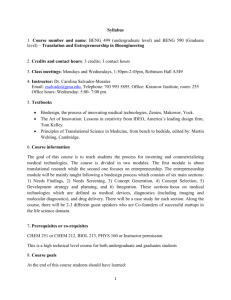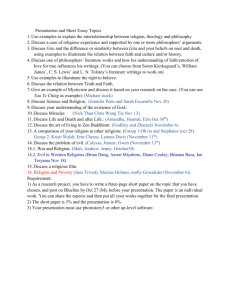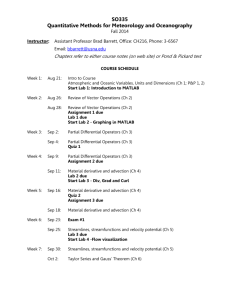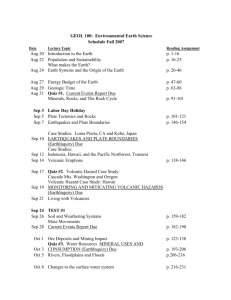Fall 2004
advertisement
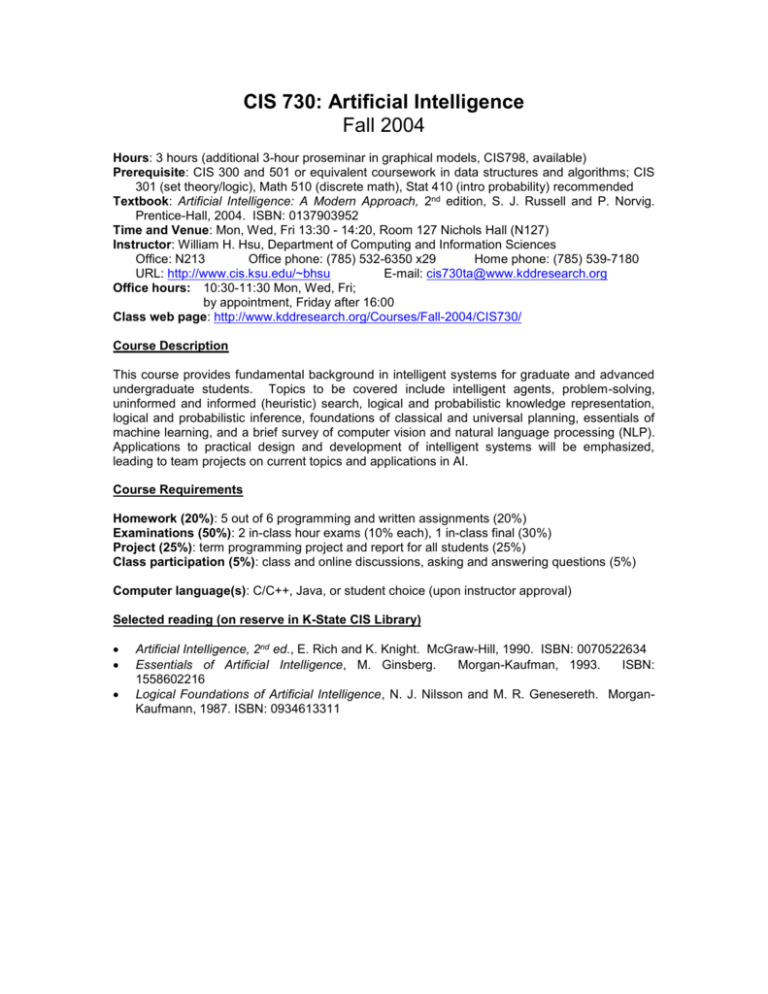
CIS 730: Artificial Intelligence Fall 2004 Hours: 3 hours (additional 3-hour proseminar in graphical models, CIS798, available) Prerequisite: CIS 300 and 501 or equivalent coursework in data structures and algorithms; CIS 301 (set theory/logic), Math 510 (discrete math), Stat 410 (intro probability) recommended Textbook: Artificial Intelligence: A Modern Approach, 2nd edition, S. J. Russell and P. Norvig. Prentice-Hall, 2004. ISBN: 0137903952 Time and Venue: Mon, Wed, Fri 13:30 - 14:20, Room 127 Nichols Hall (N127) Instructor: William H. Hsu, Department of Computing and Information Sciences Office: N213 Office phone: (785) 532-6350 x29 Home phone: (785) 539-7180 URL: http://www.cis.ksu.edu/~bhsu E-mail: cis730ta@www.kddresearch.org Office hours: 10:30-11:30 Mon, Wed, Fri; by appointment, Friday after 16:00 Class web page: http://www.kddresearch.org/Courses/Fall-2004/CIS730/ Course Description This course provides fundamental background in intelligent systems for graduate and advanced undergraduate students. Topics to be covered include intelligent agents, problem-solving, uninformed and informed (heuristic) search, logical and probabilistic knowledge representation, logical and probabilistic inference, foundations of classical and universal planning, essentials of machine learning, and a brief survey of computer vision and natural language processing (NLP). Applications to practical design and development of intelligent systems will be emphasized, leading to team projects on current topics and applications in AI. Course Requirements Homework (20%): 5 out of 6 programming and written assignments (20%) Examinations (50%): 2 in-class hour exams (10% each), 1 in-class final (30%) Project (25%): term programming project and report for all students (25%) Class participation (5%): class and online discussions, asking and answering questions (5%) Computer language(s): C/C++, Java, or student choice (upon instructor approval) Selected reading (on reserve in K-State CIS Library) Artificial Intelligence, 2nd ed., E. Rich and K. Knight. McGraw-Hill, 1990. ISBN: 0070522634 Essentials of Artificial Intelligence, M. Ginsberg. Morgan-Kaufman, 1993. ISBN: 1558602216 Logical Foundations of Artificial Intelligence, N. J. Nilsson and M. R. Genesereth. MorganKaufmann, 1987. ISBN: 0934613311 Syllabus Lecture 0 1 2 3 4 5 6 7 8 9 10 11 12 13 14 15 16 17 18 19 20 21 22 23 24 25 26 27 28 29 30 31 32 33 34 35 36 37 38 39 40 41 42 43 44 45 46 Date 2004 Aug 18 2004 Aug 20 2004 Aug 23 2004 Aug 25 2004 Aug 27 2004 Aug 30 2004 Sep 01 2004 Sep 03 2004 Sep 08 2004 Sep 10 2004 Sep 13 2004 Sep 15 2004 Sep 17 2004 Sep 20 2004 Sep 22 2004 Sep 24 2004 Sep 27 2004 Sep 29 2004 Oct 01 2004 Oct 04 2004 Oct 06 2004 Oct 08 2004 Oct 13 2004 Oct 15 2004 Oct 18 2004 Oct 20 2004 Oct 22 2004 Oct 25 2004 Oct 27 2004 Oct 29 2004 Nov 01 2004 Nov 03 2004 Nov 05 2004 Nov 08 2004 Nov 10 2004 Nov 12 2004 Nov 15 2004 Nov 17 2004 Nov 19 2004 Nov 22 2004 Nov 29 2004 Dec 01 2004 Dec 03 2004 Dec 06 2004 Dec 08 2004 Dec 10 TBD Topic Administrivia; overview of topics Intelligent agents and problem solving Intro to Search and Constraints Uninformed search: DFS, BFS, B&B Constraint Satisfaction Problems Informed search: hill-climbing, beam Informed search: A* AI Applications 1: Interaction, Games Game tree search: intro Game tree search: conclusion Knowledge representation Intro to propositional logic Propositional inference Production systems Predicates and relations First-order logic First-order knowledge bases Clausal (Conjunctive Normal) Form Unification Resolution theorem-proving / review Theorem-proving and decidability Logic programming Hour Exam 1 (Closed-Book) Classical planning / midterm review More classical planning Hierarchical abstraction planning Conditional planning and replanning Universal and reactive planning Uncertainty and probabilistic reasoning Probability review; Bayesian inference Intro to graphical models, Part I Intro to graphical models, Part II AI Applications 2: Machine Translation Inference in graphical models Introduction to machine learning Machine learning basics / review Decision trees Hour Exam 2 (Closed-Book) AI Applications 3: Robotics and HCI Learning to reason; philosophical issues Ramifications of AI Vision and perception Project presentations Project presentations Project presentations Final review FINAL EXAM (OPEN-BOOK) (Primary) Source RN Chapter 1 RN Chapter 2 RN 3, Appendix A RN Chapter 3 RN Chapter 3 RN Chapter 4 RN Chapter 4 RN Chapter 5 RN Chapter 5 RN Chapter 5 RN Chapter 6 RN Chapter 7 RN Chapter 7 RN Chapter 6 RN Chapter 7 RN Chapter 7 RN Chapter 8 RN Chapter 9 RN Chapter 9 RN Chapter 8-9 RN Chapter 9 RN Chapter 9-10 RN Chapters 2-10 RN Chapter 11 RN Chapter 11 RN Chapter 12 RN Chapter 13 RN Chapter 13 RN Chapter 14-15 RN Chapter 14 RN Chapter 15 RN Chapter 15 – RN Chapter 15 RN 18; TMM 1-2 RN 18-19, TMM 1-2 TMM 3 RN Chapters 11-15, 18 – RN Chapter 26 RN Chapter 26 RN Chapter 24 – – – RN 2-12, 14-15, 18-19 RN 2-12,14-15,18-19 RN: Artificial Intelligence: A Modern Approach, 2nd Edition, S. J. Russell and P. Norvig TMM: Machine Learning, T. M. Mitchell Lightly-shaded entries denote the due date of a written problem set. Heavily-shaded entries denote the due date of a machine problem (programming assignment).

